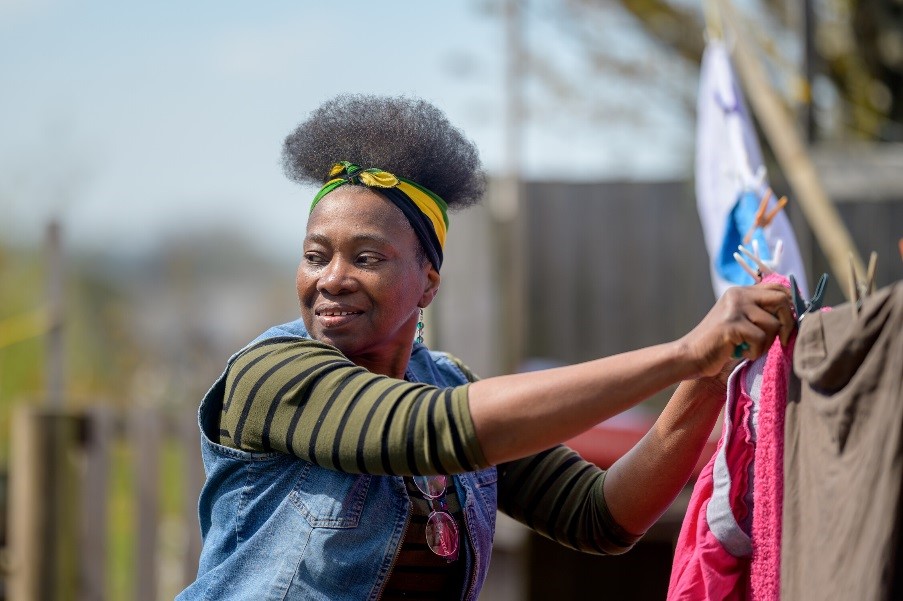Moledina, A., Magwood, O., Agbata, E., Hung, J.-H., Saad, A., Thavorn, K., & Pottie, K. (2021). A comprehensive review of prioritised interventions to improve the health and wellbeing of persons with lived experience of homelessness. Campbell Systematic Reviews, 17, e1154. https://doi.org/10.1002/cl2.1154
Please note: This research is not specific was conducted in adult populations and is not specific to older people. The stories and pictures used do not represent specific individuals – they are merely utilised to contextualise the data into a more digestible format
Picture this…
Thomas lives in rural England and works in the housing department of the local district council. In recent months, there has been a steady increase in the number of people approaching the council for homelessness assistance and the senior team are considering what they can do to best meet their needs. Thomas is keen to understand the evidence around what works best to improve the health and wellbeing of people experiencing homelessness so that he can help to ensure that the council makes the right funding decisions.

IMAGE 1: Photograph showing a person sleeping rough on a blanket outside a shop front
Photo by John Tyson on Unsplash.
Summary messages
- Permanent Supportive Housing may improve housing stability and may also reduce visits to the emergency department and admission to hospital. These benefits were seen in studies that included adults with moderate and high levels of need, and those with mental illness and substance use disorders.
- There is moderate certainty evidence that Permanent Supportive Housing increases housing stability.
- High intensity case management and income assistance interventions may improve housing stability; these interventions also improved symptoms of depression and perceived stress levels in the short term.
- The effects of the interventions on people’s quality of life, long term mental health outcomes, substance use, employment and income are less clear.
- Peer support programmes demonstrated no impact on housing relative to usual care.
- Intensive mental health interventions demonstrated moderate improvements in housing stability and often worked well with permanent housing solutions.
- Permanent Supportive Housing has major cost and policy implications and could play a key role in ending homelessness.
What the research says
A report published by the United Nations Human Rights Council in 2019 estimates that over 1.8 billion people lack adequate housing worldwide and almost 25% of the world’s urban population lives in informal accommodation e.g. slums or shanty towns. Homelessness is a stressful, lonely and often traumatic experience. People who have experienced homelessness are more likely to have poor physical and mental health than the general population and are far more vulnerable to issues relating to alcohol and drug use. Many people who experience homelessness also experience multiple disadvantages such as substance misuse or offending behaviours which can create barriers to accessing health care and support services. Homelessness among older people is a growing concern in many countries including the UK, the USA and Canada and is expected to rise as our population ages.

IMAGE 2: Photograph showing an apartment block.
Photo by Sigmund on Unsplash.
This systematic review published by the Campbell Library in June 2021 assessed the effects of a number of different types of intervention intended to tackle homelessness.
- Permanent Supportive Housing is long term housing in the community combined with support services tailored to the person’s needs and choices. Permanent Supportive Housing follows the principles of ‘Housing First’ where the ability to access housing is not contingent on abstinence from substance use.
- Income assistance consists of interventions that directly increase an individual’s available income or improve their access to basic living necessities.
- Case management interventions involve case managers who assess, plan and facilitate access to the necessary health and social services.
- Peer support includes the sharing of knowledge, experience or practical help by or with an individual with similar experience.
They also looked at the evidence for four interventions to help people experiencing homelessness access mental health care services and three interventions relating to substance use disorders.
The author team identified 86 studies of people with lived experience of homelessness that assessed the effects of one of these interventions. Most of the studies were conducted in the USA with a few conducted in Canada, the UK, the Netherlands and Australia.
Studies on the housing interventions showed significant improvements in housing stability, with potential sustained benefit for up to 5.4 years. Income assistance interventions also appeared to be effective in improving housing outcomes. Standard case management showed some potential to improve housing, with mixed evidence suggesting its added benefit, whereas peer support programmes alone did not have an impact on housing relative to usual care. The various intensive mental health interventions demonstrated moderate improvements in housing stability and often worked in combination with permanent housing.
The study authors assessed whether the interventions offered good value for money. The results for the housing interventions were mixed with some studies showing that the interventions saved money overall and some that they cost more money overall. Income assistance was associated with increased costs that were offset by added benefits. The intensive mental health interventions were found to offer good value for money.

IMAGE 3: Photograph showing a woman hanging out wahsed clothes on a line.
Photograph sourced from the Center for Ageing Better Positive Image Library.
Where is Thomas now…
Thomas found learning about the range of interventions that have been used to tackle homelessness fascinating. He was able to fully participate in the discussions at the council and felt happy that funding decisions were being made based on the best available evidence.
Jo Thompson Coon
Co-Director, Cochrane Campbell Global Ageing Partnership
Editor, Ageing Co-ordinating Group, Campbell Collaboration
University of Exeter
Please note: This research is not specific was conducted in adult populations and is not specific to older people. The stories and pictures used do not represent specific individuals – they are merely utilised to contextualise the data into a more digestible format
Reference points –
Moledina, A., Magwood, O., Agbata, E., Hung, J.-H., Saad, A., Thavorn, K., & Pottie, K. (2021). A comprehensive review of prioritised interventions to improve the health and wellbeing of persons with lived experience of homelessness. Campbell Systematic Reviews, 17, e1154. https://doi.org/10.1002/cl2.1154
Age UK Policy Position Paper: Homelessness (July 2019)
If you have any comments regarding this blog post, please contact us at globalageing@cochrane.org. We would love to hear your thoughts and answer any questions you may have.
Web editor: Monserrat Conde
